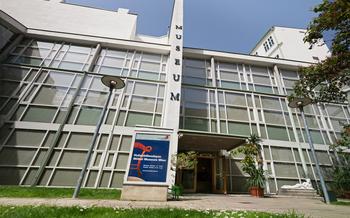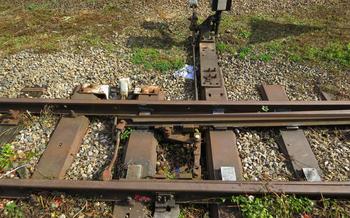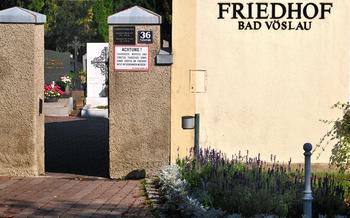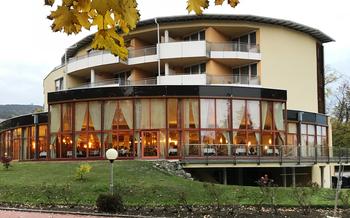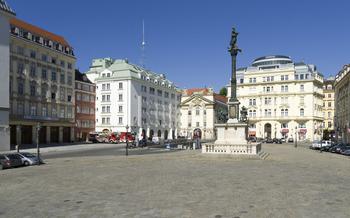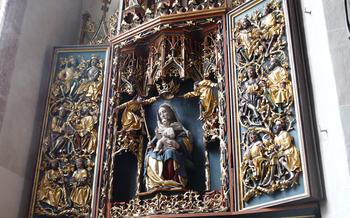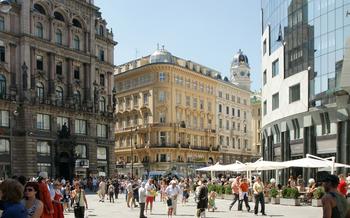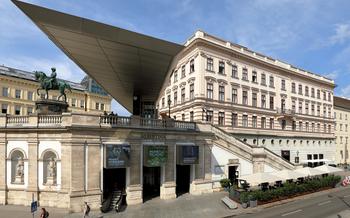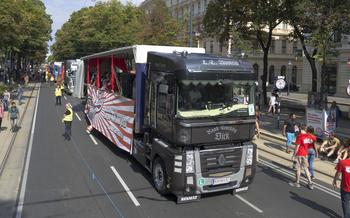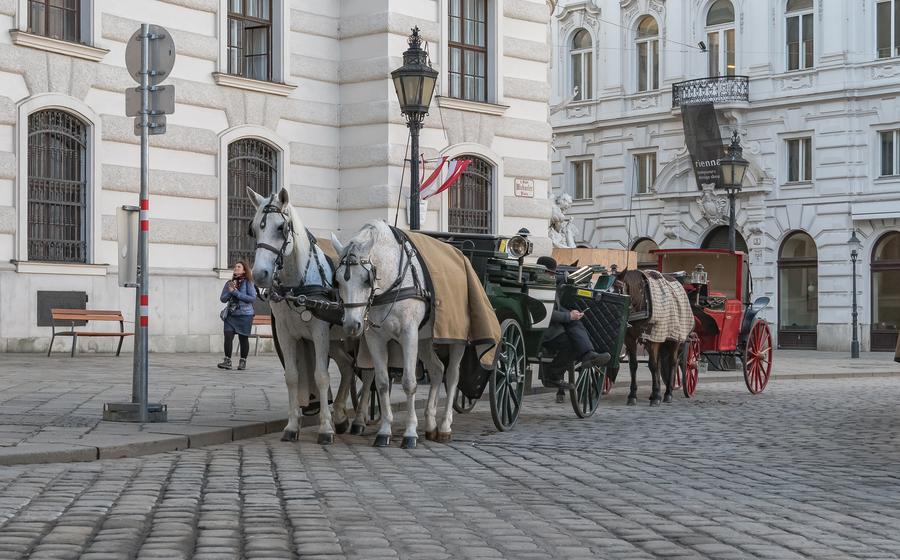
Michaelerplatz
- Michaelerplatz: A Historic Square with Imperial Charm
- Hofburg Palace: A Majestic Imperial Residence
- Michaelerkirche: A Gothic Masterpiece
- Spanische Hofreitschule: Home of the Lipizzaner Horses
- Imperial Treasury: A Treasure Trove of Habsburg Jewels
- Albertina Museum: A Haven for Art Lovers
- Augustinerkirche: A Baroque Gem
- Café Central: A Literary and Cultural Hotspot
- Mozart Statue: A Tribute to a Musical Genius
- Haus der Musik: A Journey into the World of Music
- Secession Building: A Symbol of Art Nouveau
- Naschmarkt: A Vibrant Market Experience
- Insider Tip: Exploring the Hidden Gems of Michaelerplatz
Michaelerplatz: A Historic Square with Imperial Charm
Michaelerplatz is a captivating square in the heart of Vienna, Austria, exuding imperial grandeur and historical significance. It is named after the adjacent Michaelerkirche, a magnificent Gothic church that stands as a testament to the city's rich religious heritage. The square is surrounded by an array of architectural masterpieces, including the Hofburg Palace, the Spanish Riding School, and the Albertina Museum, each contributing to the unique charm and allure of this iconic location.
Michaelerplatz has served as a significant gathering place throughout history, hosting imperial ceremonies, grand parades, and festive celebrations. It was once the main entrance to the Hofburg Palace, the winter residence of the Habsburg dynasty, and served as a stage for elaborate processions and royal events. Today, the square continues to attract visitors from around the world, who come to admire its architectural beauty, soak up its historical atmosphere, and experience the vibrant energy that permeates this enchanting urban space.
Hofburg Palace: A Majestic Imperial Residence
The Hofburg Palace stands as a testament to the grandeur and power of the Habsburg dynasty, which ruled over Austria for centuries. Originally constructed in the 13th century as the seat of the Babenberg dynasty, the palace has undergone numerous expansions and renovations over the years, reflecting the changing tastes and needs of its occupants. Today, the Hofburg is a sprawling complex of buildings, courtyards, and gardens, serving as the official residence of the Austrian President and housing a wealth of historical treasures.
Architectural Highlights:
The Hofburg Palace boasts a diverse array of architectural styles, showcasing the evolution of tastes and trends over the centuries. The oldest surviving part of the palace is the Schweizerhof, a late Gothic structure dating back to the 15th century. The Amalienburg, built in the 16th century, exemplifies the Renaissance style with its intricate ornamentation and symmetrical façade. The Leopoldine Wing, added in the 17th century, features a Baroque design with elaborate stucco work and allegorical sculptures. The Michaelertrakt, constructed in the 18th century, represents the transition to Neoclassicism, with its clean lines and restrained ornamentation.
Guided Tours and Exhibitions:
Visitors to the Hofburg Palace can embark on guided tours to explore the opulent state rooms, imperial apartments, and ceremonial halls that once hosted lavish receptions, official ceremonies, and diplomatic gatherings. Highlights of the tour include the Imperial Apartments, furnished with exquisite period furniture and artwork, the Sisi Museum, dedicated to the life and legacy of Empress Elisabeth of Austria, and the Silver Collection, showcasing a stunning array of tableware and decorative objects.
Michaelerkirche: A Gothic Masterpiece
The Michaelerkirche, or Church of St. Michael, is a magnificent Gothic masterpiece that stands proudly on the Michaelerplatz. It has a rich history dating back to the 13th century, when it was built as a parish church for the surrounding community. Over the centuries, it has undergone several renovations and expansions, resulting in a blend of architectural styles that showcases the evolution of Gothic architecture.
The church's exterior is characterized by its intricate stone carvings, flying buttresses, and a towering spire that reaches towards the sky. The main entrance features a stunning tympanum depicting the Archangel Michael vanquishing the dragon, symbolizing the triumph of good over evil.
Inside, the Michaelerkirche is equally impressive. The nave is adorned with elegant ribbed vaults, delicate tracery, and colorful stained-glass windows that cast a mystical glow on the interior. The high altar is a masterpiece of Gothic art, featuring intricate carvings, sculptures, and a magnificent altarpiece depicting scenes from the life of Jesus Christ.
Spanische Hofreitschule: Home of the Lipizzaner Horses
The Spanische Hofreitschule, located in the heart of Vienna's imperial district, is a world-renowned institution dedicated to the preservation and performance of the centuries-old tradition of classical dressage. Founded in 1572 by Emperor Maximilian II, the school has been instrumental in shaping the art of equestrian ballet and maintaining the legacy of the Lipizzaner breed, a majestic line of horses renowned for their intelligence, elegance, and grace.
History and Significance:
The history of the Spanische Hofreitschule is deeply intertwined with the Habsburg dynasty, who ruled over the Austro-Hungarian Empire for over 600 years. The school was established as a way to train horses for the imperial court and to showcase the prowess of the Habsburg cavalry. Over the centuries, the school has faced numerous challenges, including wars, fires, and economic turmoil, but it has managed to endure and preserve its traditions.
The Lipizzaner Breed:
The Lipizzaner horses, synonymous with the Spanische Hofreitschule, are a unique and highly prized breed. Originally bred in the Lipica stud farm in Slovenia, these horses are known for their intelligence, athleticism, and calm temperament. The Lipizzaners are meticulously trained from a young age, undergoing years of rigorous dressage to master the intricate movements and choreography that characterize the school's performances.
Guided Tours and Performances:
The Spanische Hofreitschule offers guided tours that provide visitors with a glimpse into the daily life of the horses and riders. Visitors can witness the horses being groomed, exercised, and trained, and learn about the history and traditions of the school. The highlight of any visit is the opportunity to attend a performance by the Lipizzaner stallions, a captivating spectacle of elegance, precision, and harmony.
Imperial Treasury: A Treasure Trove of Habsburg Jewels
History and Significance: The Imperial Treasury in Vienna is one of the most important treasuries in the world, housing a vast collection of Habsburg jewels and artifacts that span centuries of imperial rule. It was originally established in the 16th century by Emperor Ferdinand I and has since grown to become a repository of priceless treasures that reflect the wealth and power of the Habsburg dynasty.
Crown Jewels and Artifacts: The Imperial Treasury is home to some of the most spectacular and historically significant crown jewels in Europe. Among the highlights are the Imperial Crown of Austria, crafted in 1602 and adorned with over 2,000 precious stones, including a 200-carat ruby; the scepter, featuring a large pear-shaped sapphire; and the orb, representing the world topped by a cross. Visitors can also admire the insignia of the Order of the Golden Fleece, an exclusive chivalric order established by Philip the Good, Duke of Burgundy, in the 15th century.
Guided Tours and Highlights: To fully appreciate the richness of the Imperial Treasury, guided tours are highly recommended. Knowledgeable guides provide insights into the history, significance, and symbolism of the various jewels and artifacts. Visitors can learn about the Habsburgs' passion for collecting, their diplomatic gifts, and the role these treasures played in imperial ceremonies and events. The tour also includes a visit to the Secular Treasury, which houses a collection of non-religious objects such as the world's largest emerald, weighing an astonishing 2,860 carats.
Albertina Museum: A Haven for Art Lovers
The Albertina Museum, located in the heart of Vienna's historic center, is a treasure trove of art and culture. Founded in 1776 by Duke Albert of Saxe-Teschen, the museum houses a world-renowned collection of graphic art, paintings, and sculptures, spanning from the Middle Ages to the present day.
The Albertina's collection boasts over a million works of art, including masterpieces by Albrecht Dürer, Michelangelo, and Rembrandt. Visitors can admire the delicate beauty of Dürer's "Praying Hands," marvel at the grandeur of Michelangelo's "Madonna and Child with St. John the Baptist," and be mesmerized by the intricate details of Rembrandt's "Self-Portrait with Two Circles."
The museum's collection is not limited to old masters. It also features works by modern and contemporary artists, such as Pablo Picasso, Andy Warhol, and Roy Lichtenstein. Visitors can trace the evolution of art through the centuries, from the Renaissance to the present day, and gain insights into the changing styles and techniques of different artistic movements.
Guided tours of the Albertina Museum are available in several languages, providing visitors with an in-depth understanding of the collection and its highlights. The museum also hosts temporary exhibitions throughout the year, showcasing the works of specific artists or exploring particular themes.
Whether you are an art enthusiast, a casual visitor, or simply looking for a place to immerse yourself in culture, the Albertina Museum is a must-visit destination in Vienna. Its diverse collection, knowledgeable guides, and beautiful setting make it a truly unforgettable experience.
Augustinerkirche: A Baroque Gem
The Augustinerkirche, located on the northern side of Michaelerplatz, is a magnificent Baroque masterpiece that stands as a testament to Vienna's rich religious heritage. Its history dates back to the 14th century when it was founded by the Augustinian order. Over the centuries, the church underwent several renovations and expansions, culminating in its current Baroque appearance, designed by the renowned architect Johann Bernhard Fischer von Erlach.
The exterior of the Augustinerkirche is characterized by its imposing facade, adorned with intricate carvings, sculptures, and a grand portal. The interior is equally impressive, featuring a spacious nave, elegant side chapels, and a breathtaking dome that floods the space with natural light. The church is renowned for its exquisite frescoes, which depict scenes from the life of Saint Augustine and other religious figures.
One of the highlights of the Augustinerkirche is the Imperial Crypt, located beneath the church. This crypt serves as the final resting place for many members of the Habsburg dynasty, including Emperor Franz Joseph I and Empress Elisabeth (Sisi). Visitors can explore the crypt and pay their respects to the former rulers of Austria, whose elaborate sarcophagi and memorials adorn the walls.
The Augustinerkirche is not only a place of worship but also a significant cultural and historical landmark. It has witnessed numerous important events throughout its history, including the weddings of several Habsburg emperors and empresses. Today, the church continues to be a popular destination for both locals and tourists who come to admire its architectural splendor and learn about its fascinating past.
Café Central: A Literary and Cultural Hotspot
Since its opening in 1876, Café Central has become an iconic institution in Vienna's cultural landscape. Situated close to the Hofburg Palace, this grand café exudes an air of elegance and history. Its walls have witnessed countless gatherings of intellectuals, artists, and musicians, making it a hub of literary and cultural discourse.
Famous Patrons and Anecdotes:
Throughout the years, Café Central has attracted a diverse clientele of renowned figures. Among its famous patrons were prominent writers such as Stefan Zweig, Arthur Schnitzler, and Peter Altenberg. It was here that they sought inspiration, engaged in lively debates, and crafted their literary masterpieces. The café's ambiance provided a fertile ground for artistic expression, fostering a vibrant intellectual community.
One memorable anecdote involves the writer Hermann Broch, who frequented Café Central during his time in Vienna. He was known for his frugal nature and often ordered only a glass of water. To make up for his modest consumption, he would spend hours scribbling on the café's tablecloths, using them as impromptu writing paper.
Viennese Coffee Culture:
Café Central is an embodiment of Vienna's renowned coffee culture. Here, the art of coffee making is elevated to a refined ritual. Skilled baristas prepare Viennese specialties such as the Melange, a harmonious blend of coffee and steamed milk, or the Einspänner, a strong coffee topped with whipped cream. Accompanying these beverages is a tempting array of pastries and cakes, showcasing the Viennese love for sweets.
Indulge in a leisurely afternoon at Café Central, immersing yourself in its rich history and vibrant atmosphere. Take a seat at one of the marble-topped tables, order a cup of coffee and a slice of Sachertorte, and let the creative spirit of this legendary café inspire you.
Mozart Statue: A Tribute to a Musical Genius
In the heart of the Michaelerplatz stands a majestic bronze statue dedicated to one of Austria's most beloved composers, Wolfgang Amadeus Mozart. Unveiled in 1896, this impressive monument pays homage to the musical genius who captivated the world with his extraordinary compositions.
The statue, crafted by the renowned sculptor Viktor Tilgner, portrays Mozart at the height of his creative powers. Seated on a pedestal adorned with cherubs and musical instruments, Mozart's pensive gaze seems to reflect his profound connection to his art. The intricate details of the statue, from the flowing folds of his clothing to the delicate expression on his face, showcase Tilgner's exceptional craftsmanship.
Beyond its artistic merit, the Mozart statue holds historical significance. It was commissioned by the Vienna Mozart Society to commemorate the 100th anniversary of Mozart's death. The choice of Michaelerplatz as its location was deliberate, as it is situated near the Hofburg Palace, where Mozart spent much of his time performing for the imperial court.
The statue has become a beloved landmark and a popular gathering spot for music enthusiasts and tourists alike. Visitors often pause to admire the intricate details of the sculpture and pay their respects to the legendary composer. Whether you're a classical music aficionado or simply appreciate the beauty of art, the Mozart statue is a must-see when exploring Michaelerplatz.
Haus der Musik: A Journey into the World of Music
Nestled in the heart of Vienna's cultural district, the Haus der Musik invites visitors on an immersive journey into the world of music, spanning centuries and genres. Housed in a stunning Art Nouveau building, this interactive museum celebrates the rich musical heritage of Austria and pays tribute to some of the world's most renowned composers, including Mozart, Beethoven, and Strauss.
Through a series of captivating exhibits, visitors can explore the lives and works of these musical giants, gaining insights into their creative processes and the cultural context in which they lived. Interactive displays, multimedia presentations, and listening stations allow visitors to engage with music in a hands-on way, experiencing the power and beauty of sound firsthand.
Highlights of the museum include a virtual conducting experience, where visitors can lead a digital orchestra, and a sound lab, where they can experiment with different instruments and create their own musical compositions. The museum also features a collection of rare and historical musical instruments, as well as temporary exhibitions showcasing contemporary music and sound art.
Whether you're a seasoned musician, a casual music lover, or simply someone with an appreciation for the arts, the Haus der Musik offers an unforgettable and enriching experience that will leave you inspired and entertained.
Secession Building: A Symbol of Art Nouveau
History and significance
The Secession Building, also known as the Secessionshaus, is an iconic landmark of Vienna's artistic heritage. It was built between 1897 and 1898 by the architect Joseph Maria Olbrich, as a symbol of the Secession movement, a group of artists who broke away from the traditional styles of the time. The building was designed to be a showcase for Secessionist art and architecture, and it quickly became a gathering place for artists, intellectuals, and patrons of the arts.
Architectural features
The Secession Building is a masterpiece of Art Nouveau architecture. It features a striking golden dome, which is covered with laurel leaves and topped with a bronze statue of Apollo, the Greek god of the arts. The façade is decorated with intricate metalwork and colorful mosaics, depicting scenes from Greek mythology and the arts. The interior of the building is equally impressive, with its elegant staircase, marble floors, and stained-glass windows.
Exhibitions and events
The Secession Building currently houses the Secession Gallery, which hosts temporary exhibitions of contemporary art. The gallery has a long history of showcasing groundbreaking art, and it has played a significant role in shaping the development of modern art in Austria. In addition to exhibitions, the Secession Building also hosts various events, such as lectures, concerts, and performances.
Naschmarkt: A Vibrant Market Experience
Immerse yourself in the vibrant atmosphere of the Naschmarkt, one of Vienna's most famous and beloved markets. Located just a short walk from Michaelerplatz, this bustling marketplace has been a hub of commerce and culinary delights for centuries.
Stroll through the colorful stalls, where vendors display an array of fresh produce, exotic spices, artisanal cheeses, and mouthwatering pastries. Indulge in the tantalizing aromas of freshly baked bread, roasted coffee beans, and sizzling sausages. Sample local specialties like Viennese schnitzel, potato dumplings, and traditional strudels.
Beyond its culinary offerings, the Naschmarkt is also a melting pot of cultures and a showcase for Vienna's diverse artistic scene. Browse unique souvenirs, handmade crafts, and vintage treasures. Listen to live music performances, watch street artists create vibrant murals, or simply soak up the lively ambiance of this vibrant market.
Don't miss the opportunity to visit the Naschmarkt Flea Market, held every Saturday, where you can hunt for antiques, vintage clothing, and one-of-a-kind items. During the summer months, the market transforms into a lively outdoor festival, with food stalls, live music, and cultural events.
Whether you're a food lover, a culture enthusiast, or simply looking for a unique and vibrant experience, the Naschmarkt is a must-visit destination in Vienna. Immerse yourself in the sights, sounds, and flavors of this iconic market, and discover the hidden gems that make it a beloved local treasure.
Insider Tip: Exploring the Hidden Gems of Michaelerplatz
Beyond the iconic landmarks of Michaelerplatz, there are hidden gems waiting to be discovered by curious explorers. One such gem is the Looshaus, a striking modernist building designed by Adolf Loos in 19Its clean lines and minimalist facade stand in stark contrast to the ornate architecture of the surrounding buildings, making it a unique and captivating sight.
Another hidden treasure is the Judenplatz, a small square located just a few steps away from Michaelerplatz. This historic square is home to the Judenplatz Museum, which sheds light on the rich history and culture of Vienna's Jewish community. The museum's exhibits and artifacts provide a glimpse into the lives and experiences of Jewish people in Vienna, from the Middle Ages to the present day.
For those seeking a unique culinary experience, a visit to the Kantine Wien is a must. This charming restaurant is housed in a former canteen building and offers a delightful fusion of traditional Austrian cuisine with modern culinary twists. The menu features seasonal dishes made with fresh, local ingredients, ensuring a memorable dining experience.
To capture the essence of Michaelerplatz, be sure to explore its narrow side streets and hidden courtyards. These hidden corners often reveal charming cafes, quaint shops, and stunning architectural details that are easily missed by those who stick to the main tourist routes. Take your time to wander and discover the hidden treasures that make Michaelerplatz a truly special place.

